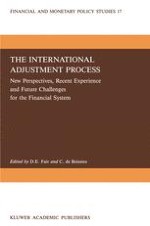The papers collected in this volume are those presented at the fourteenth Colloquium arranged by the Societe Universitaire Europeenne de Recher ches Financieres (SUERF), which took place in Helsinki in May 1988. The Society is supported by a large number of central banks and commercial banks, by other financial and business institutions and by personal subscriptions from academics and others interested in monetary and financial problems. Since its establishment in 1963 it has developed as a forum for the exchange of information, research results and ideas among academics and practitioners in these fields, including central bank officials and civil servants responsible for formulating and applying monetary and financial policies, national and international. A major activity of SUERF is to organise and conduct Colloquia on subjects of topical interest to its members. The titles, places and dates of previous Colloquia for which volumes of the collected papers were published are noted, on the last page of this volume. Volumes were not produced for Colloquia held at Tarragona, Spain in October 1970 under the title "Monetary Policy and New Developments in Banking" and at Strasbourg, France in January 1972 under the title "Aspects of European Monetary Union".
